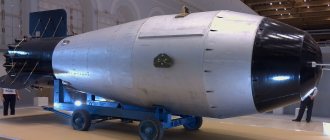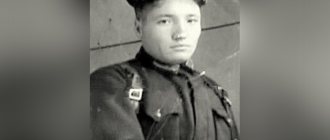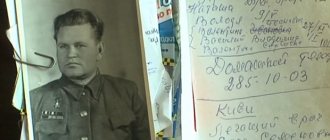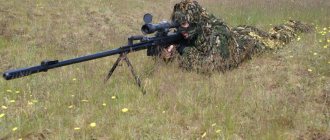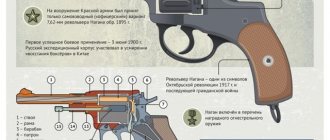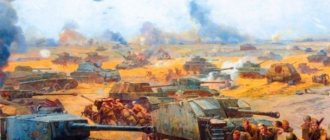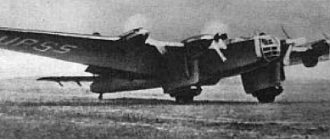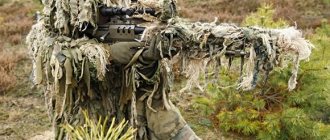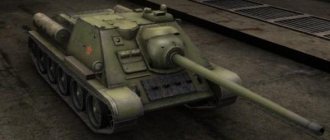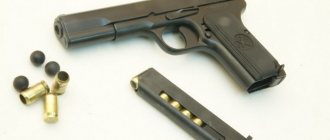Snipers of World War II
SNIPERS OF THE WEHRMACHT
Sniper at Stalingrad. 1942
Among historians, there is an opinion that the Germans only when faced with “sniper terror” on the Eastern Front “came to their senses” and began to actively engage in sniping in 1942. However, this is an absolutely erroneous statement. Having “harassed” its opponents with sniper warfare during the First World War, according to the Treaty of Versailles, Germany was deprived of the right not only to have snipers, but also to produce sniper rifles and scopes. Not forgetting the importance of the sniper at the front, with the formation of SS structures, the German command cleverly hid snipers in these paramilitary detachments and secretly trained them. Sniper training was also hidden under airfield security even in Luftwaffe units. It should be noted that the training of snipers, the production of rifles and sights were personally supervised by Heinrich Himmler and Hermann Goering. Sniper training in pre-war Germany lasted at least two years. Therefore, it is completely incorrect to consider this approach to sniping in Germany as oblivion.
In the post-war years, the Germans only managed to slightly improve the design of optical sights, increasing the image amplification factor. New 4x and 8x scopes, in theory, made it possible to confidently hit targets at distances of up to 800 m, but during the Second War, most German sniper rifles still had scopes with 3x and 4x magnification. The design of the optical sight lenses themselves has been improved, making shooting in limited light conditions possible.
At the beginning of the war, the Wehrmacht had a sufficient number of snipers and rifles with sights, but there was no subject for their use. Neither in Poland, nor in France, nor in Norway, nor in Crete were there targets for the mass use of snipers. They carried out ordinary statutory tasks, which were not particularly noticeable in offensive battles. Naturally, the German command did not see the need to increase the number of snipers or increase the number of their training.
German sniper and observer near Voronezh. 1941
It is also important to emphasize that the basics of sniper training in both the Red Army and the Wehrmacht were practically the same. The instructions of both armies took into account the experience of the Soviet-Finnish war. It was this experience that pushed the USSR to a sharp increase in the training of the number of snipers, which either “overslept” or did not appreciate the next reform of the Soviets. As a result, indeed, in the winter of 1941-1942, when the Wehrmacht first went on the defensive, the balance of snipers was not on its side. The German command began to take decisive measures, orders appeared, sniper schools were opened, and cadets were selected at the fronts. This was all accepted by historians as a fact of the appearance of sniping in the Wehrmacht.
In 1942, numerous three-month courses were launched, the duration of training for which was subsequently increased to six months. At the front, the most successful shooters were selected, as a rule, those who already had at least 20 victories. Shooters from the Jaeger units also trained here, where, usually, soldiers who were well familiar with weapons from civilian life served. Short-term training of riflemen was also carried out at front-line courses. The cadets received rifles and scopes that remained with them forever. Sniper schools conducted daily exercises in shooting, camouflage, observation, enemy detection, etc. By 1944, the development of German sniping had reached its peak. In particular, at least 30 sniper schools were formed. By order of the Luftwaffe command, educational films “Invisible Weapon: Sniper in Combat” and “Field Training of Snipers” were filmed for use in training ground units. Both films were shot quite competently and of very high quality, even from the heights of today: here are the main points of special sniper training, the most important recommendations for actions in the field, and all this in a popular form, with a combination of game elements. A memo, widely circulated at the time, called “The Ten Commandments of the Sniper” read:
- Fight selflessly. - Fire calmly and carefully, concentrate on each shot. Remember that rapid fire has no effect. - Shoot only when you are sure that you will not be detected. - Your main opponent is the enemy sniper, outsmart him. — Don’t forget that a mining shovel prolongs your life. — Constantly practice determining distances. - Become a master of terrain and camouflage. — Train constantly - on the front line and in the rear. - Take care of your sniper rifle, don’t give it to anyone. — Survival for a sniper has nine parts – camouflage and only one – shooting.
Luftwaffe sniper in position. Eastern front. 1942
It is necessary to note the tactical developments of German sniping, which are still used today by many armies of the world. For the first time, the Germans proposed to distinguish between “amateur snipers” (field snipers in today’s sense) and “professional snipers.” Each rifle squad was staffed by two amateur snipers - ordinary soldiers who knew how to shoot accurately. Their standard rifle was equipped with a 4x optical sight. Whenever possible, they received additional sniper training. As snipers, they could only be used when necessary. Each company was assigned two professional snipers, who were armed with a sniper rifle with a 6x optical sight (if available, high aperture, for shooting in the dark). These same snipers, if necessary, could create a sniper group with the involvement of amateur snipers. However, in practice it was difficult for the Germans to implement this theory.
German snipers were most effective in Normandy in June 1944 during the landing of the Anglo-American allies, where they faced the same “sniper terror” as the Red Army soldiers once did on the Mannerheim Line. German snipers knew the terrain well and skillfully camouflaged their positions. Hedges became their favorite shelter. Snipers dug in near them, mined the approaches, and set traps in the bushes. The best method of dealing with them remained mortar and artillery strikes on the intended position. Here, the Allies encountered unusual German tactics. A common sniper tactic is to fire a shot, rarely two, and change position to avoid enemy return fire. But in Normandy, German snipers fired continuously, without even trying to move. In the end, they were destroyed, but before that such a “suicide” managed to inflict very serious damage.
Luftwaffe sniper pair. Eastern front. 1942
Snipers always worked in pairs - one shoots, the other conducts observation. Frequent changes of position and camouflage were considered the key to a sniper’s survival. The most common tasks were: the destruction of observers, spotters, commanders, machine gunners and gun crews. Snipers followed the attacking forces and engaged the most fortified enemy positions, machine gun nests and anti-tank gun crews. Often, snipers crossed the front line before the advance of their troops and during their artillery preparation, destroying enemy commanders. In defense, the sniper's primary task was to destroy attacking commanders at long distances, which often stopped the offensive. Sniper duels were considered a dangerous but necessary activity and were fought until the enemy was completely destroyed.
German snipers preferred to work at medium distances - up to 500 m. They fired more at the body than at the head, which, firstly, increased the likelihood of hitting with the first shot, thereby increasing the shooter’s chances of not being detected, and, secondly, the target it was still guaranteed to fail. When repelling the attack, the snipers did not pay attention to the first three or four lines of attackers, and tried to hit as many of the soldiers advancing behind them in the stomach as possible. Hearing the shrill screams of the wounded behind them, those advancing in the front ranks lost their presence of mind, and the attack began to choke. At this moment, snipers were shooting at the first lines of the enemy. Soldiers who were closer than fifty meters to the sniper were shot in the head or heart - they were afraid to leave the wounded close to them. Those retreating were shot in the kidney area, which brought them unbearable pain. In these cases, the wounded began to literally scream and howl like an animal. As a result, the attack often ended abruptly. In such battles, the sniper hit up to 20 people, although these victories were not credited to the sniper account.
Sniper position near a damaged tank. Eastern front. 1943
Snipers preferred camouflage jackets with a shrapnel pattern or an oak leaf pattern. Face masks were also used, although on a limited scale. The helmets were covered with camouflage fabric or mesh. The Germans believed that shooters with low and average levels of training hit better shots using sights with low magnification - up to 4x. Stronger scopes could only be used by high-class snipers.
German gunsmiths did not spoil snipers with a variety of sniper rifles. The main weapon was the Mauser 98 rifle. Adopted in 1898, it was produced until 1945. More than 18 thousand rifles were converted into sniper rifles before World War II. To install an optical sight, the bolt handle was bent down.
Mauser Gew rifle. 98 with optical sight
Based on the Mauser 98 rifle, a carbine was created in 1935 under the designation Mauser 98k. For use as a sniper weapon, specimens that gave maximum accuracy were selected from standard carbines. About 200 thousand carbines were equipped with optical sights.
Mauser 98k carbine with ZF-41 optical sight
In 1943, under the impression of the Soviet SVT-40 rifle, the production of the Gewehr 43 self-loading rifle was launched in Germany. By the end of the war, 53.4 thousand rifles received “optics”. The rifle was superior to the outdated Mauser Gew. 98", but was significantly inferior to the Mauser 98k carbine.
Sniper rifle with optical sight G-43 (W)
It should be noted that German snipers, in the absence of the coveted “Gewehr 43”, tried to get a captured Soviet Mosin sniper rifle, which was converted to a German cartridge. And in this form, the rifle showed better results than in the original version. And considering that the captured goods were not even counted in thousands of guns, there was plenty to choose from.
A sniper with a Mauser Kar98k rifle with a Dialytan RH-36 scope. Eastern front. 1943
In contrast to the limited range of sniper rifles, the German industry produced a good dozen telescopic sights for them. The first type of telescopic sight, officially adopted in 1939 by the German army, was the four-fold "ZF-39" with graduations at a distance of up to 1200 m. In 1941, another sight was adopted - the "ZF-41" with one and a half times increase. A rifle with such a scope was positioned as a rifle for high-precision shooting, and not as a sniper. In 1942, various commercial sights with magnification from 4X to 6X, poorly suited for military service, were adopted under the designation “ZF-42”. In 1943, a cheap and reliable telescopic sight “ZF-4” or “ZF-43” with a 4X magnification, designed under the influence of the Soviet PU sight, appeared. It was intended for the G43 self-loading rifle, but it was not possible to produce the G43 in sufficient quantities and the sight had to be adapted to the Kar.98k rifle. There were other types of sights: the Opticotechna, Dialytan, Hensoldt & Soehne and the rare Carl Zeiss Jena Zielsechs. However, it was not possible to identify the incredible ten-fold Zeiss optics of German snipers, captured in numerous stories by both front-line soldiers and historians. The collapse of another legend.
Share to:
Pages: 3
Wound
Already at that time, Joseph Allerberger began to understand that, as a machine gunner, there was little chance of surviving until the end of the war. The thing is that they were most often exposed to fire from large guns. Everything changed after being slightly wounded in the arm.
It was the fifth day of fighting, and a shell exploded not far from Josef. After the end of the battle, he went to a makeshift hospital. Here, Allerberger saw terrible pictures: there were many wounded around. Since his damage was not critical, he had to wait in line for three hours. The wound was treated without anesthesia. The soldier was held by the corporal, and the doctor skillfully cleaned and stitched the wound.
Memory
In 2005, the book “Sniper on the Eastern Front” was published. The work consists of the memoirs of Joseph Allerberger. The book received not only positive reviews. Many critics believe that it contains distorted information, and Joseph himself exaggerates his achievements.
Allerberger decided to tell his memories only fifty years after the end of the war. In long conversations with the writer, the sniper told his vision of the war. The reader is given the opportunity to see these horrors through the eyes of an ordinary German rifleman.
It is worth saying that all the names in the book have been replaced. This was done to protect Allerberger. After all, even in his own country he is considered not an outstanding sniper, but a brutal killer. However, all events are real, the names of other characters are also fictitious.
Vacation
Like many WWII snipers, Josef, thanks to his excellent service, was able to earn a vacation. In 1944, he went to Germany, where he took training courses and learned a lot about himself. Now he has become a more calculating and professional shooter.
After this, the Mauser 98k became the new weapon of the German sniper. Often he had to use a Walter 43 rifle. Allerberger spoke positively about this weapon, noting its extreme effectiveness at different distances.
Education
After recovery, Joseph Allerberger was assigned to simple work. At the same time, he decided to try in any way to avoid service, being listed as a machine gunner. Since Josef was a carpenter, he was tasked with restoring gun butts and also sorting them.
One day Allerberger came into possession of a Russian sniper rifle. Josef wanted to practice shooting with it, which he asked the non-commissioned officer to do. Immediately the soldier showed impressive results and managed to establish himself as a good sniper.
Recovery of health lasted fourteen days, after which Allerberger was supposed to return to the company. As a farewell, the non-commissioned officer gave him a sniper rifle with an optical sight.
Return to the front
In August 1943, Josef returned to the company and received a black badge “For Wounding” and award documents from the sergeant. Allerberger managed to avoid falling into the machine gunners' camp. Now he's a sniper. The news of his appearance quickly spread throughout the regiment. Josef was greeted warmly by his colleagues.
Soon the commander approached Allerberger and gave him the task of destroying the Soviet sniper. He had been haunting German soldiers for a long time. The very first shot from a rifle without a scope was accurate. The Germans rushed into battle. A hundred meters later, Allerberg and his colleagues discovered the body of the killed sniper. The bullet hit him right in the eye, leaving a huge hole in his head. The shooter was about sixteen years old. Josef felt sick at the sight of his victim. At that moment, as he recalled, he was overwhelmed with feelings of guilt, pride and horror. However, none of his colleagues tried to condemn him.
For about nine months, the German sniper fought with the Soviet three-line team. Joseph himself noted that only senior ranks could count the killed enemies, despite the fact that he was a field sniper. Enemies not killed with sniper weapons did not count. So the official statistics of victims may differ significantly from the real ones.
End of the war
The end of World War II found Josef in Czechoslovakia. By this point, he had become a fairly recognizable personality, thanks to Goebbels' propaganda. His photographs appeared several times in German newspapers. However, such popularity could have played a disservice for him. Fearing being captured, Allerberger decided to do everything to return home.
For about two weeks, Joseph and his colleagues made their way through the Alpine forests. We had to move at night to avoid running into American army patrols. On June 5, 1945, Allerberger managed to reach his native village. She had not changed at all, as he himself mentioned, as if she had slept through the entire war. It was quiet and calm around.
Allerberger had to attend many battles. However, the sniper not only survived, but also did not receive serious injuries.
Joseph's subsequent life is not particularly unusual. He worked as a simple carpenter, like his father. Allerberger died on March 3, 2010 in the city of Salzburg (Austria). At that time, the German sniper was 85 years old.
